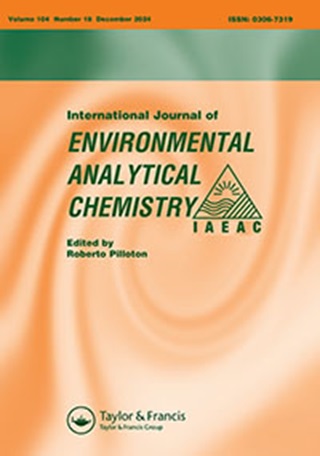酸修饰玉米芯去除水溶液中抗生素环丙沙星的吸附模拟
IF 2.5
4区 化学
Q3 CHEMISTRY, ANALYTICAL
International Journal of Environmental Analytical Chemistry
Pub Date : 2023-10-04
DOI:10.1080/03067319.2023.2263383
引用次数: 0
摘要
摘要制药工业废水中环丙沙星(CIP)等突发性污染物的去除对水的净化具有重要意义。以含纤维素材料的玉米芯为原料,制备了一种环保型硝酸改性吸附剂,用于吸附水中的环丙沙星抗生素。采用SEM, FTIR, BET, EDX和TGA技术对吸附剂进行了表征。表征结果表明,预处理后的农业废弃物前驱体的吸附剂孔隙度、表面官能团和表面积(156.39 m2/g)均有所增加。考察了吸附剂用量、初始浓度、pH、接触时间、温度等参数对吸附效果的影响,确定了最佳吸附pH值为7。发现CIP药物的最大单层吸附量为51.55 mg/g。Freundlich等温线成功地解释了生成的实验结果,表明物理吸附过程的表面是不均匀的。反应的速率决定步骤主要是颗粒内扩散,动力学模型由拟二级过程表示,暗示化学吸附。热力学分析表明,吸附过程为吸热过程(∆Ho < 0)和自发过程(∆Go < 0),随机程度增加(∆So < 0)。最后,需要注意的是,吸附在吸附剂上的CIP在0.1 mol L−1 HNO3的作用下很容易解吸,吸附剂对所研究药物的吸附具有良好的可重复使用性。因此,本研究提出了酸预处理玉米芯的可行性,以经济有效地处理水或类似的含药废水中的环丙沙星。关键词:预处理玉米;cociproflo沙星;抗生素;吸附;平衡模型;披露声明作者未报告潜在的利益冲突。本研究没有从公共、商业或非营利部门的资助机构获得任何特定的资助。本文章由计算机程序翻译,如有差异,请以英文原文为准。
Adsorption modelling on the removal of ciprofloxacin antibiotic from aqueous solution by acid-modified corn cob
ABSTRACTThe removal of emergent contaminants like ciprofloxacin (CIP) from effluents discharged from pharmaceutical industries is important for water purification. An environmental and eco-friendly nitric acid modified adsorbent produced from corn cob containing cellulosic materials was used for the sequestration of ciprofloxacin antibiotic from aqueous media. The adsorbent was characterised using SEM, FTIR, BET, EDX, and TGA techniques. The results of the characterisations depicted enrichment of the adsorbent porosity, surface functional groups and surface area (156.39 m2/g) of the agro-waste precursor after pretreatment. The effects of various adsorption parameters, including adsorbent dosage, initial concentration, pH, contact time, and temperature, were investigated, with an optimal pH value of 7 being determined. The maximum monolayer adsorption capacity for the CIP drug was found to be 51.55 mg/g. The Freundlich isotherm successfully explained the generated experimental results indicating a heterogeneous surface for the physisorption process. The rate-determining step of the reaction was predominately dominated by intraparticle diffusion, and the kinetic models were represented by pseudo-second-order processes that suggested chemisorption. The analysis of thermodynamics revealed that the adsorption process was endothermic (∆Ho < 0), and spontaneous (∆Go < 0) with an increasing degree of randomness (∆So < 0). Finally, it should be noted that CIP loaded on the adsorbent could be easily desorbed with 0.1 mol L−1 HNO3 and the adsorbent showed good reusability for adsorption of the studied drug. Therefore, this study proposed the viability of acid-pretreated corn cob for economically effective treatment of ciprofloxacin in water or similar pharmaceutical-laden wastewater.KEYWORDS: Pretreated corn cobciprofloxacin antibioticadsorptionequilibrium modelsthermodynamics AcknowledgmentsThe authors wish to thank the co-authors who contributed immensely to the success of the research.Disclosure statementNo potential conflict of interest was reported by the author(s).Additional informationFundingThis research did not receive any specific grant from funding agencies in the public, commercial, or not-for-profit sectors.
求助全文
通过发布文献求助,成功后即可免费获取论文全文。
去求助
来源期刊
CiteScore
5.90
自引率
7.70%
发文量
373
审稿时长
4.4 months
期刊介绍:
International Journal of Environmental Analytical Chemistry comprises original research on all aspects of analytical work related to environmental problems. This includes analysis of organic, inorganic and radioactive pollutants in air, water, sediments and biota; and determination of harmful substances, including analytical methods for the investigation of chemical or metabolic breakdown patterns in the environment and in biological samples.
The journal also covers the development of new analytical methods or improvement of existing ones useful for the control and investigation of pollutants or trace amounts of naturally occurring active chemicals in all environmental compartments. Development, modification and automation of instruments and techniques with potential in environment sciences are also part of the journal.
Case studies are also considered, particularly for areas where information is scarce or lacking, providing that reported data is significant and representative, either spatially or temporally, and quality assured. Owing to the interdisciplinary nature of this journal, it will also include topics of interest to researchers in the fields of medical science (health sciences), toxicology, forensic sciences, oceanography, food sciences, biological sciences and other fields that, in one way or another, contribute to the knowledge of our environment and have to make use of analytical chemistry for this purpose.

 求助内容:
求助内容: 应助结果提醒方式:
应助结果提醒方式:


